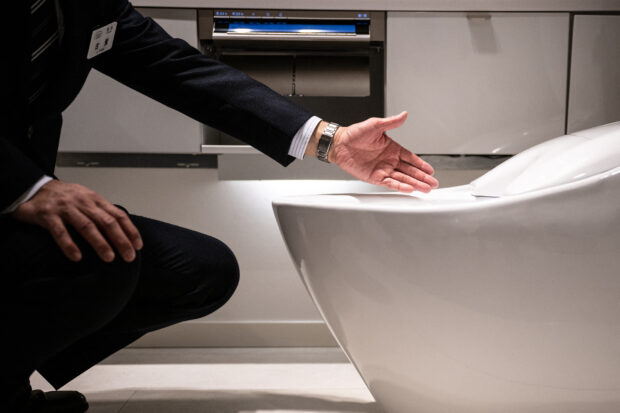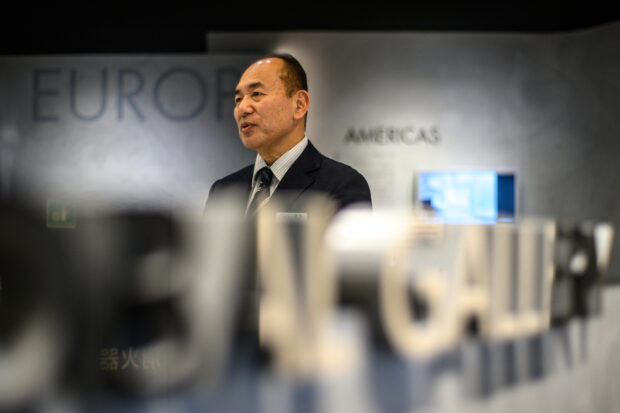
In this picture taken on February 15, 2024, museum director Junichi Koga presents the washlet functions of one of the toilets in the museum of Japanese toilet manufacturer TOTO in the city of Kitakyushu, Fukuoka Prefecture. As Japan plays host to a record influx of tourists, one of the country’s more private attractions — the high-tech toilet — is becoming a must-have in luxury bathrooms worldwide. (Photo by Philip FONG / AFP)
KITAKYUSHU, Japan — As Japan plays host to a record influx of tourists, one of the country’s more private attractions — the high-tech toilet — is becoming a must-have in luxury bathrooms worldwide.
With their warm seats and precision spray technology, bidet toilets are the norm in Japan, where more than 80 percent of homes have one, according to a government survey.
Now sales are surging abroad and especially in the United States, led by A-list bidet fans such as Drake, the Kardashians, and Alexandria Ocasio-Cortez.
Japanese company TOTO, which pioneered the electric bidets it claims have sparked “a global revolution from wiping to washing”, says overseas revenue for toilets has roughly doubled from 100 billion yen ($673 million) in 2012.
The pandemic was a key driver, bringing a home-renovation boom but also germ-conscious consumers desperate for an alternative to toilet paper after shelves were cleared by panic-buyers.
Senior TOTO executive Shinya Tamura, who oversees international business, told AFP the brand’s growth has been a word-of-mouth success.

In this picture taken on Feb 15, 2024 museum director Junichi Koga speaks during an interview with AFP, at the museum of Japanese toilet manufacturer TOTO, in the city of Kitakyushu, Fukuoka Prefecture. (Photo by Philip FONG / AFP)
When people first learn how the toilets’ water jets work, with pressure and temperature controls, “there’s an image that it’s not pleasant”.
But “we can’t explain how good it is with words. You need to experience it”, Tamura said.
“After a while, most users can’t live without it.”
READ: A showcase of Japanese innovation
The company’s international net sales for housing equipment are currently less than a third of those in Japan.
It wants to boost sales in the Americas by 19 percent over two years to “establish a solid position” there and offset less urgent demand in China.
But with more people in the market for a squeaky clean bum, US competitors are challenging TOTO and its Japanese rivals such as Panasonic and LIXIL for their throne.
‘Smartest toilet’
At a major tech fair in Las Vegas this year, the marketing manager of US brand Kohler called its Numi 2.0 — which takes spoken instructions via an in-built Amazon Alexa — “the smartest toilet that exists”.
Just like top-end Japanese models, the Numi 2.0 has an automatic deodorizer and a motion-activated lid that opens when you enter the bathroom and closes when you leave.
Its spray wand has pulsating and oscillating functions, and users can adjust the warm-air dryer in minute detail.
But such pampering comes at a price: around $8,500 to $10,000, compared to around $500 for more basic bidet seats.
Americans who travel to Japan are often inspired to upgrade their toilet, a salesman at Ardy’s Bath Collection in Beverly Hills told AFP.
“They see it in the airport, and they see it in public restrooms, and they use it, and they’re like, ‘wow, this is great,'” he said.
READ: Technologies of the hygienic self
Bidets are “popular everywhere” but it’s still a “private experience” and “weird to talk about” for some customers.
Although fancy Japanese-style toilets are fast becoming a status symbol, TOTO’s executives have long fought prudishness when trying to expand abroad.
After the US launch of its Washlet bidet in 1986, the firm struggled to place advertisements, and its pop-up event was kicked out of a high-end mall because other stores complained.
‘Does it hurt?’
How things have changed in the share-all internet era.
“Why am I nervous? Does it hurt? Is it cold?” 21-year-old Canadian Spencer Barbosa, who has 10 million TikTok followers, said in a clip of her trying a Japanese toilet.
Superstar rapper Drake made a grand public gesture of gifting his friend DJ Khaled luxury TOTO loos in 2022.
And US congresswoman Ocasio-Cortez joked in an Instagram video last year that she was shopping for a bidet after going to Japan because “life will never be the same”.
Funnily enough, when TOTO first began selling bidets — to hospitals in Japan — it imported them from the United States, but users complained that the stream was unstable.
The company was founded in 1917 as a father and son from a wealthy business family who tried to bring Western-style ceramic toilets to Japan.
With sewer systems still undeveloped and squat-style toilets common, the business struggled, so they relied on tableware sales until habits began to change after the 1970 World Expo in Osaka, said Junichi Koga, head of TOTO’s history museum.
More than 300 employees helped develop and test the Washlet by specifying their preferred location for the water jet.
Now, worldwide, TOTO has sold 60 million Washlets — featured in episodes of “The Kardashians” and “South Park”, which parodied the company as “TOOTTOOT”.
As the bidet craze grows, even the trepidatious might be converted in time, the Ardy’s salesman said.
He recommends customers put in the necessary electrics when they remodel their bathroom, telling them: “You could always buy it down the line”.

